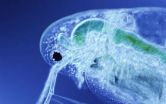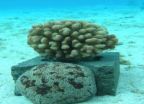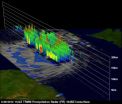"So long as the nation is fully committed to securing its weapons stockpile and provides sufficient resources for doing so, the U.S. has the technical capabilities to maintain safe, reliable nuclear weapons into the foreseeable future without the need for underground weapons testing," said Ellen D. Williams, chief scientist at BP and chair of the committee that wrote the report. "In addition, U.S. and international technologies to monitor weapons testing by other countries are significantly better now than they were a decade ago."
U.S. verification of compliance with the CTBT would be accomplished through a combination of information gathered by the U.S. military and intelligence agencies, the International Monitoring System (IMS), which is now more than 80 percent complete, and other publicly available geophysical data. U.S. global monitoring capabilities are superior to those of the IMS and can focus on countries of national concern, the report says. However, the IMS provides valuable data to the U.S., both as a common baseline for international assessment and as a way of disclosing potential violations when the U.S. needs to keep its own data classified. Therefore, the U.S. should support both the completion of the IMS and its operations regardless of whether CTBT enters into force, the report says.
The improvements in the IMS and the U.S. monitoring network reduce the likelihood of undetected nuclear explosion testing and inhibit development of new types of strategic nuclear weapons, the report says. Technologies for detecting clandestine testing in four environments -- underground, underwater, in the atmosphere, and in space -- have improved significantly in the past decade. In particular, seismology, the most effective approach for monitoring underground nuclear explosion testing, can now detect underground explosions well below 1 kiloton in most regions. A kiloton is equivalent to 1,000 tons of chemical high explosive. The nuclear weapons that were used in Japan in World War II had yields in the range of 10 to 20 kilotons.
The report acknowledges that weapons threats could arise without being detected even if a test ban existed. For example, a rudimentary nuclear weapon could be built and deployed without testing by a nation with access to sufficient material, or a previously tested weapon design might be manufactured without further testing by a country that obtained the design. Such weapons could pose local or regional threats "of great concern," but they would not require the U.S. to return to weapons testing in order to respond, the report says. The U.S. already has or could produce weapons of equal or greater capability based on its own nuclear explosion test history. In addition, if the U.S. determined that there was a technical need to develop a new type of nuclear weapon that has not been tested previously, it could invoke the "supreme national interest clause" and withdraw from the CTBT.
The administration and Congress should develop and implement a comprehensive plan with a clear strategy for maintaining the nation's nuclear deterrence capabilities and competencies, the report says. The nation's Stockpile Stewardship Program, which collectively maintains the safety and reliability of the U.S. nuclear weapons arsenal in the absence of testing, has had "significant advances" in technical knowledge and capability since the 2002 report, such as completion and operation of new major research facilities. The report calls for a strong national commitment to recruiting and sustaining high-quality workers, repairing aging infrastructure, and strengthening the science, engineering, and technology base for both stockpile maintenance and monitoring capabilities.
Initiated nearly 50 years ago under President Eisenhower, negotiations for the CTBT were completed in 1996. The treaty has been signed by 182 nations, including the United States. The pact, which would prohibit nuclear weapons testing in all environments, would establish a network of monitoring stations to help track compliance and provide for inspections of suspected tests. It would permit research, development, and design activities by the nuclear-weapon states, but experiments producing a nuclear yield would be forbidden.
The treaty would enter into force after ratification by the 44 countries that either already possessed nuclear weapons or had nuclear reactors in 1996. To date, 36 have done so, including Russia, the United Kingdom, and France. The U.S. Senate failed to give its advice and consent to ratification in 1999. The Obama administration has indicated that it will seek ratification. The U.S. has observed a testing moratorium since October 1992.
###
The study was sponsored by the U.S. Department of Energy, the U.S. Department of State, the Carnegie Corporation of New York, and the National Academy of Sciences. The National Academy of Sciences, National Academy of Engineering, Institute of Medicine, and National Research Council make up the National Academies. They are private, nonprofit institutions that provide science, technology, and health policy advice under a congressional charter. The Research Council is the principal operating agency of the National Academy of Sciences and the National Academy of Engineering. For more information, visit http://national-academies.org. A committee roster follows.
Contacts:
Molly Galvin, Senior Media Relations Officer
Shaquanna Shields, Media Relations Assistant
Office of News and Public Information
202-334-2138; e-mail news@nas.edu
Pre-publication copies of The Comprehensive Nuclear Test Ban Treaty: Technical Issues for the United States are available from the National Academies Press; tel. 202-334-3313 or 1-800-624-6242 or on the Internet at http://www.nap.edu. Reporters may obtain a copy from the Office of News and Public Information (contacts listed above).
NATIONAL RESEARCH COUNCIL
Division on Policy and Global Affairs
Committee on Reviewing and Updating Technical Issues Related to the Comprehensive Nuclear Test Ban Treaty
Ellen D. Williams1 (chair)
Chief Scientist
BP
London
Marvin L. Adams
Professor of Nuclear Engineering
Texas A&M University
College Station
Linton F. Brooks
Independent Consultant
Vienna, Va.
Theodore W. Bowyer
Scientist and Program Manager
Pacific Northwest National Laboratory
Richland, Wash.
Donald D. Cobb
Senior Adviser
Defense Threat Reduction Agency
Los Alamos, N.M.
Richard L. Garwin1, 2, 3
Fellow Emeritus
IBM Thomas J. Watson Research Center
Yorktown Heights, N.Y.
Raymond Jeanloz1
Professor in Earth and Planetary Science and Astronomy
University of California
Berkeley
Richard W. Mies
President and CEO
The Mies Group Ltd.
Fairfax Station, Va.
C. Bruce Tarter
Director Emeritus
E.O. Lawrence Livermore National Laboratory
Livermore, Calif.
Subcommittee on Seismology to the Committee to Review and Update Technical Issues Related to the Comprehensive Nuclear Test Ban Treaty
Lynn R. Sykes 1 (chair)
Higgins Professor Emeritus of Earth and Environmental Sciences
Lamont-Doherty Earth Observatory
Columbia University
Palisades, N.Y.
Hans Hartse
Staff Seismologist
Los Alamos National Laboratory
Los Alamos, N.M.
Paul G. Richards
Emeritus Mellon Professor of Natural Sciences
Columbia University
New York City
Gregory Van Der Vink
Visiting Lecturer
Department of Geosciences
Princeton University
Princeton, N.J.
William R. Walter
Scientific Staff
Earth and Energy Division
E.O. Lawrence Livermore National Laboratory
Livermore, Calif.
STAFF
Benjamin J. Rusek
Study Co-Director
1 Member, National Academy of Sciences
2 Member, National Academy of Engineering
3 Member, Institute of Medicine
END



